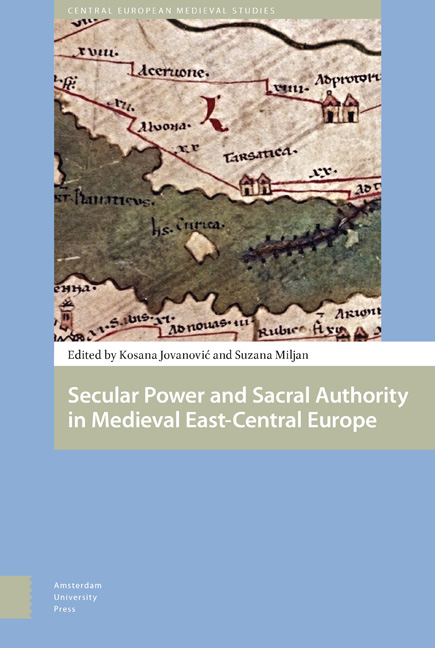Book contents
- Frontmatter
- Contents
- List of Figures and Tables
- Acknowledgements
- Foreword
- Folklore of the Medieval Kings of Hungary: Preliminary Research Report
- Variations on Nobility in Central and South-Eastern Europe: An Introduction
- The Changes of Office of Ban of Slavonia after the Mongol Invasion in Hungary (1242-1267)
- The Reconstruction and Role of Roads in the Formation of a Medieval Cultural Landscape: The Example of Episcopal Estates of Dubrava, Ivanić and Čazma
- From Castle-Warrior to Nobleman: Case Study of a Family of Slavonian Lesser Nobility
- Late Medieval Village in Turopolje (Slavonia): The Example of Donja Lomnica
- Economic Development and Transformation of the Pauline Monasteries near Senj under the Frankapan Patronage
- The Society of the Noble Judges in Northeastern Hungary during the Reign of King Sigismund (1387-1437)
- Development of Ragusan Diplomatic Service in the First Half of the Fifteenth Century: Father and Son at the Court of Duke Sandalj Hranić
- Croatian Students at the University of Prague in the Fifteenth Century
- A Contribution to Medieval Croatian Diplomatics: Cyrillic Charters of Croatian Nobility from the Franciscan Monastery on Trsat in Rijeka
- Peter of Crkvica, a Man Who Could Be Trusted: The Career of a Middle-Ranking Cleric and Diplomat in the Kingdom of Hungary in Mid-Fifteenth Century
- The Nobility of the Despotate of Serbia between Ottoman Empire and Hungary (1457-1459)
- List of Contributors
- Index
The Changes of Office of Ban of Slavonia after the Mongol Invasion in Hungary (1242-1267)
Published online by Cambridge University Press: 12 December 2020
- Frontmatter
- Contents
- List of Figures and Tables
- Acknowledgements
- Foreword
- Folklore of the Medieval Kings of Hungary: Preliminary Research Report
- Variations on Nobility in Central and South-Eastern Europe: An Introduction
- The Changes of Office of Ban of Slavonia after the Mongol Invasion in Hungary (1242-1267)
- The Reconstruction and Role of Roads in the Formation of a Medieval Cultural Landscape: The Example of Episcopal Estates of Dubrava, Ivanić and Čazma
- From Castle-Warrior to Nobleman: Case Study of a Family of Slavonian Lesser Nobility
- Late Medieval Village in Turopolje (Slavonia): The Example of Donja Lomnica
- Economic Development and Transformation of the Pauline Monasteries near Senj under the Frankapan Patronage
- The Society of the Noble Judges in Northeastern Hungary during the Reign of King Sigismund (1387-1437)
- Development of Ragusan Diplomatic Service in the First Half of the Fifteenth Century: Father and Son at the Court of Duke Sandalj Hranić
- Croatian Students at the University of Prague in the Fifteenth Century
- A Contribution to Medieval Croatian Diplomatics: Cyrillic Charters of Croatian Nobility from the Franciscan Monastery on Trsat in Rijeka
- Peter of Crkvica, a Man Who Could Be Trusted: The Career of a Middle-Ranking Cleric and Diplomat in the Kingdom of Hungary in Mid-Fifteenth Century
- The Nobility of the Despotate of Serbia between Ottoman Empire and Hungary (1457-1459)
- List of Contributors
- Index
Summary
The article examines the changes of the office of ban of Slavonia (totius Sclavonie) regarding their relationship with Dalmatia, especially with cities of Trogir and Split between 1242 and 1267. This period begins with the Mongol invasion, which forced King Béla IV to flee to Dalmatia. After the Mongol invasion, the royal policy particularly changed towards this territory, and the bans of all Slavonia gained power, because besides this office, they held the title of the duke of Slavonia. Moreover, they extended their rule over the secular administration of Trogir and Split, the two most important cities for the royal court of Hungary. This article will examine the period of the office of ban, when the royal power was relatively strong in Dalmatia, whose end corresponded with the end of the office of Ban Roland. Thus, the focus is on the period of three bans (Denis Türje, Stephen Gutkeled, Roland Rátót) during the reign of King Béla IV.
The formation of the ban's authority
The authority of bans stemmed from the kings of Hungary, and they were akin to viceroys in the territory, which they governed in the name of the king. Bans had great judicial power and military roles in Slavonia. Besides the power entrusted to them by the kings, they could expand their authority. As it will be seen in the following lines, they acquired the secular leadership of Dalmatian towns, and formed their own private system of patron-client relationships (familiaritas) from the mid-thirteenth century. The increase of the authority was traceable in the financial administration of Slavonia. The beginning of the coinage of bans can be dated to 1255, and the seat of the chamber was first Pakrac, then Zagreb from 1255 onwards. Bans minted ban's deniers, which were high quality silver coins imitating the pennies of Friesach. Although it was a significant change in the economic history of Slavonia, it did not influence Dalmatia at all. The coinage in Dalmatia was independent both from Slavonia and other parts of the Kingdom, because there were mostly Venetian silver and Byzantine gold coins spread there. The first coins minted in Hungary and distributed in Dalmatia can be connected with the Angevin rule in the fourteenth century.
- Type
- Chapter
- Information
- Publisher: Amsterdam University PressPrint publication year: 2018



